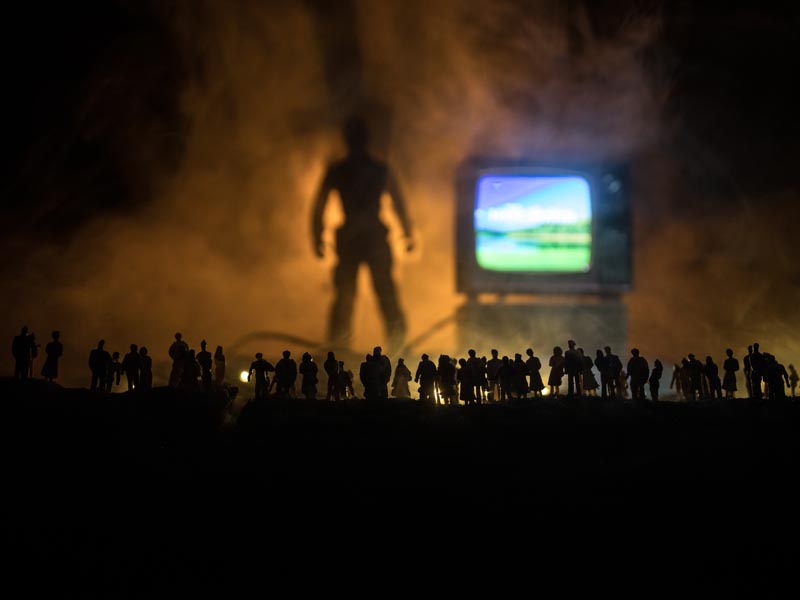
- 16 August 2023
Share:
In the leadership industry, whether we’re involved in research, development, or practice, our efforts mostly focus on leaders. While this is important work, a leader-centric orientation not only means the contributions of followers and followership are too often neglected, but also, I fear, that we’re paying too little heed to what is happening in our wider context and its implications for leadership. Of specific focus in this blog is the polluting impact of mis- and disinformation in creating a context that poses an increasing threat to efforts to foster good leadership in our governments and organizations.
That leaders must pay heed to the context in which they operate to have any hope of leading well is hardly a controversial proposition — it’s something introductory textbooks routinely point out. Leaders’ misreading of their strategic context — those Political, Economic, Social, Technological, Legal, or Environmental factors emphasized in the widely taught PESTLE model — can all too readily give rise to the pursuit of deeply flawed initiatives, informed by poor quality decisions.
Consider, for example, Putin’s invasion of Ukraine and the myriad of ways in which this ill-conceived venture has unraveled on him right from the outset. Whether it’s because he bought into his own propaganda or that he’s a “narcissistic megalomaniac,” Putin seriously misjudged his own forces, Ukraine’s determination to retain its autonomy, Zelenskyy’s leadership, and the reaction from the international community. As the war drags on, Putin has now faced outright mutiny from within. Keith Grint counsels that in all this Putin has thus “unwittingly sow(ed) the seeds of your own demise.”
Followers’ values, thoughts, feelings, and expectations are also a profoundly important contextual feature. Consider, for example, how U.S. President George W. Bush, newly elected but lacking credibility, was able to quickly rally a nation behind him following 9-11, with a televised address from the Oval Office that very night. In his speech, Bush embodied for Americans a calm resolve not to be overwhelmed by the horrific events of that day, helping to quell the anxieties people were naturally feeling and offering reassurance that the American government could and would be able to respond to the attack.
While the specifics may vary greatly in what they imply for leaders, then, it is evident that context routinely matters for leadership. As the leadership studies field developed, this significance was recognized in the situational/contingency models that emerged in the 1960s, highlighting a range of contextual factors said to inform how leaders should or could act, and rejecting prior efforts to determine a universally “best” approach. Certain propositions thus came to be widely taught, influencing practitioner understandings: that task and follower factors inform what leader behaviors are effective or necessary; that certain situations are more or less “favorable” to leaders; and that “substitutes” to leadership may sometimes render its necessity or desirability much less important.
Yet, while such acknowledgements of the significance of context are now embedded in contemporary understandings, direct attention to questions of context remain largely at the margins of leadership research and development. In part this arises because “context” is such an ambiguous term. How broadly or narrowly one defines it, what factors it includes and how significant those are thought to be, and the time span covered in any analysis of “context” are, in many ways, a highly subjective decision.
Defining and measuring what one means by “context” is therefore a problematic, possibly unsolvable issue. And, in the context of a field where precise measurement of tightly defined variables has come to be regarded by so many as the only reliable way in which we can determine the truth about leadership, that’s a clear disincentive for exploring issues of context. Within the confines of the paradigmatic assumptions and methodological practices that presently dominate leadership and organizational studies, in other words, the forces discouraging engagement with such ill-defined issues are deeply entrenched. As a consequence, leadership research and development has come to excel in the science of precisely measuring trees but is weak in the art of making sense of the forest.
Practitioners, of course, have no such latitude. In a world characterized by conditions of volatility, uncertainty, complexity, and ambiguity, they must attempt to make some kind of sense of what this means for their particular context and formulate a response. This requires leaders to build their capacity to cope with a messy reality that will frequently defy centralized or top-down control.
While we are culturally primed to pay attention to those contextual factors that we construct as being in the nature of an immediate crisis, a more amorphous, slower-moving contextual factor deserving of attention is the growing influence of organized and widely shared mis- and disinformation and what this may imply for the emergence of a social-political context increasingly conducive to irresponsible and undesirable forms of leadership.
While there are a variety of definitions, misinformation is often distinguished from disinformation by highlighting how the latter involves the intentional spreading of information that is false, misleading, or inaccurate for profit, ideological purposes, or to produce harm. While mis- and disinformation can oftentimes reflect a conspiratorial narrative and worldview, this need not always be the case. Either way, the growing influence of such narratives both reflects and exacerbates a growing mistrust in institutions, authority figures, science, fact-based journalism, and other credible ways of distinguishing falsehood and fantasy from reliable information. But not only do mis- and disinformation give rise to an epistemic shattering of a shared sense of reality, they also have the potential to radicalize people’s beliefs, foster a political climate wracked by polarization, and even incite people to acts of terrorism.
These forces have already given rise to events of historic significance. The 2016 Brexit referendum was saturated with lies deliberately spread by the “leave” campaign. Boris Johnson’s key role in that helped advance his political career. His subsequent premiership showed him to be an “incompetent liar,” albeit one whose failings cost many Britons their lives while tarnishing that nation’s reputation. Trump’s “big lie” — that the 2020 election was “stolen” — motivated the January 6th attempted insurrection. Trump now openly courts Q-Anon supporters, even though the FBI has expressed “concern” about their potential for violence.
In my own country of Aotearoa New Zealand, disinformation in the form of the “great replacement” conspiracy theory, which promotes hateful White supremacist and Islamophobic views, was a key influence motivating the Christchurch mosque shooting, that killed 51 people and attempted to kill another 40. Mis- and disinformation also played a key role in facilitating unlawful protests and anti-government sentiment in relation to its pandemic response that included an avalanche of misogynistic hate, often a prevalent feature of disinformation, directed at former Prime Minister Jacinda Ardern. Just one down-stream effect of this is its potential to deter other women with leadership aspirations. Even now, after pandemic-related protections eased, those radicalized by mis- and disinformation have continued to mobilize on a range of other issues that have no connection with their original grievance, exemplifying how these narratives pull people away from dominant social norms and into a morass of hate and lies.
To be clear, mis- and disinformation doesn’t only affect political leaders. Organizational leaders may also feel its effects. Anti-trans activists, who frequently spread disinformation, advocated boycotts of BudLight beer due to its association with transgender influencer Dylan Mulvaney. The company received bomb threats and sales dropped 10.5% compared to the same period for the previous year. Retailer Target has likewise been pressured for selling Pride Month merchandise, with direct threats made against their staff. Again, these disruptions come from those immersed in mis- and disinformation narratives.
All these examples make clear that mis- and disinformation have a corrupting influence on social norms and on institutional arrangements and practices that enable dialogue, rather than violence, as the way to resolve differences. Their influence erodes people’s capacity to act peacefully, respect the rule of law and due process, and pay heed to objectively verifiable facts and credible notions of truth — all of which are essential to ensuring democratic forms of governance can function. In so doing, they also erode the conditions in which good leadership has a better chance of succeeding — and where at least some safeguards against toxic leadership are in place. The growing influence of mis- and disinformation on our wider social and political context thus urgently warrants the attention of those of us engaged in the leadership industry. At a minimum, we need to be able to offer useful advice to leaders grappling with those motivated by these malign influences about strategies and approaches that might help. Parts of the forest that provides the shelter needed for good leadership to flourish are burning. If we want to save the trees, it’s time to take a broader view.

Dr. Suze Wilson is a leadership scholar and senior lecturer at Massey University, Auckland, Aotearoa New Zealand. Her research examines issues of power, identity, gender, ethics, discourse, practice, context and crisis in relation to leadership and its development. Her doctoral thesis won the 2014 Fredic M. Jablin Doctoral Dissertation Award given by the ILA in partnership with the Jepson School of Leadership Studies. Her work has appeared in the Journal of Business Ethics, Organization, Organizational Dynamics, Leadership and Culture and Organization. Suze’s books are Thinking differently about leadership (2016), Revitalizing leadership (2018), written in collaboration with Stephen Cummings, Brad Jackson and Sarah Proctor-Thomson, and After leadership, which she edited in collaboration with Brigid Carroll and Josh Firth. She is currently involved in editing the forthcoming Routledge Critical Companion to Leadership Studies along with David Knights, Owain Smolovic-Jones and Helena Liu. She is an Associate Editor of the journal Leadership and also writes public commentary for The Conversation. Prior to entering academia Suze held a range of senior leadership roles in several government agencies, the New Zealand postal service, in a trade union and in the student union movement.


